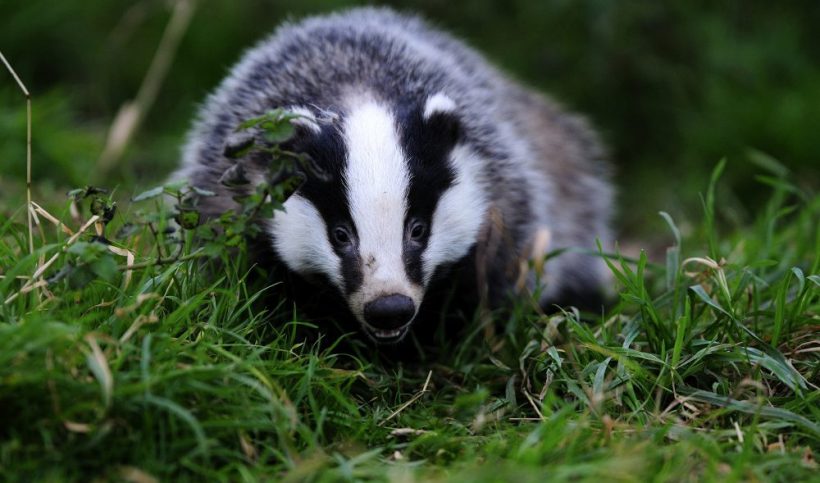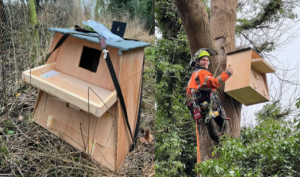Badgers set to benefit from new government strategy
Tuesday 15th October 2024

If you’d prefer to listen to this blog, please click on the audio file
We’re big fans of badgers here at Science Oxford; they can be slightly unruly tenants from time to time, prone to leaving trails of destruction and digging latrine pits wherever they chose, but I love them. That’s why we were interested to read the announcement by the government at the end of August about their new strategy that will help better understand a deadly disease, improve the health of badger populations, and bring an end to the controversial badger cull.
An iconic mammal
I’ve probably seen more badgers than most due to a few projects Science Oxford has been involved in, as well as on bike rides at dusk in my local woods, but my fondness for badgers was formed long before I first saw one. Badgers were regular characters in literature when I was a child – the noble and powerful Lords and Ladies in the Brian Jacques’ Redwall novels, wise old Mr Badger in Kenneth Grahame’s The Wind in the Willows, and the gruff Tommy Brock of the Peter Rabbit stories by Beatrix Potter – where they were typically portrayed as powerful, if slightly surly, animals.
As one of the UK’s larger wild mammals, they are indeed powerfully built members of the Mustelidae family (that includes stoats, ferrets and otters), with short legs and distinctive black and white fur. They are seldom seen due to their nocturnal behaviour and, in spite of their fictional portrayal, they’d be unlikely to be cozy with a family of woodland animals, being omnivores who as well as eating fruit and nuts, roots and earthworms, are also particularly fond of rabbit or hedgehog, and not as a friend!
However, badgers are not quite at the top of the food chain. Believe it or not, badgers were once a staple on menus in the middle ages. Celebrity chef Clarissa Dickson Wright caused controversy recounting seeing badger ham being sold as a bar snack in West County pubs as a teenager and suggesting it make a return, when launching a book a few years ago. This attention-seeking story came at a turning point in the badger’s relationship with humans. In 2013, a decision was made that would have serious consequences on the UK badger population…
Bovine tuberculosis
For a long time, badgers have been blamed for the spread of bovine tuberculosis (bTB), a disease that strikes fear in the heart of our cattle farmers and responsible for the compulsory slaughter of over 278,000 catt le in the last decade (DEFRA, 2024). Bovine tuberculosis is caused by the bacterium Mycobacterium bovis and, in addition to cows and badgers, infects a number of other mammals including pigs, foxes, deer and goats. The disease can spread to humans consuming infected milk with fatal consequences, but such transfer is very rare since milk pasteurisation was introduced in the 1930s. It is related to, but not the same as, the bacterium that causes human tuberculosis, and cannot transfer from human to human. Evidence suggests that the main route of bTB transmission is from cow to cow, but badgers have been blamed for spreading it to cattle where they share the same environment.
A cause for debate
A study carried out by Imperial College in 2013 (Donnelly & Nouvellet, 2013), found that only 6% of cattle catch TB from badgers, but that this then leads to more than half of the bTB cases due to subsequent cow-to-cow transmission. This blame has been seen as unfair given that the badgers themselves most likely catch bTB from the cattle in the first place, while the high transmission within cattle is due to the intensive conditions some farmed animals are kept in. The outcome of the study has caused much debate; needless to say, the topic is highly divisive, but the government decided to introduce a policy of culling badgers to control the spread of the disease, a policy that has led to the death of 230,000 badgers since 2014 (DEFRA, 2024).
More recently, a number of studies have been carried out to examine the efficacy of the badger culls and results have been varied. Some have found no effect on the levels of bTB (Torgerson et al. 2024; Langton et al, 2022), others have found localized reductions, while some even found increases in infection at the edge of cull regions and infection rates within badger populations to rise (Downs et al., 2019).
New direction
A few weeks ago, the government made an announcement to change its policy on bTB control, stating that it aims to bring the badger cull to an end within this Parliament and announcing a strategy aiming to eliminate bTB by 2038. This includes plans to carry out new badger population surveys, to introduce vaccine trials on cows and to undertake a programme of badger vaccinations, overseen by its catchily-named ‘Badger Vaccinator Field Force’.
Badger vaccinations
Since 2020, we’ve been helping lead the way by taking part in the Oxfordshire Badger Group (OBG)’s local vaccination programme. among our site’s population of animals (watch the YouTube clip showing a badger released after vaccination). This initiative is run purely by volunteers and funded through crowd funding.
If you are interested in supporting or getting involved with their work, visit their website.
Hopefully, this new national strategy can bring about the end to this disease without the need to destroy our wonderful woodland neighbours.
More information:
- Government announcement covered on BBC News
- Animal Aid factsheet



